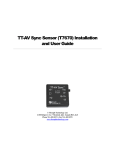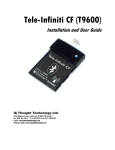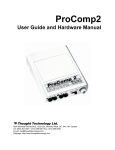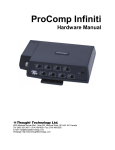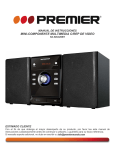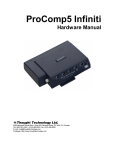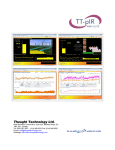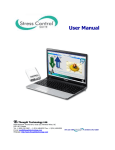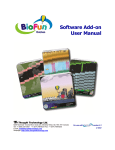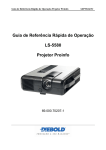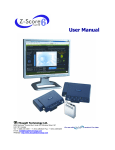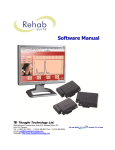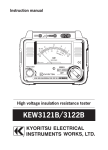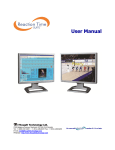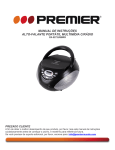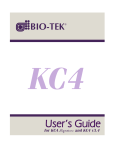Download EEG-Z3 (SA7680Z) - Thought Technology, Ltd.
Transcript
EEG-Z3 (SA7680Z) User Guide Thought Technology Ltd. CAUTION U.S. federal law restricts this device to sale by or on the order of a physician or any other practitioner licensed by law of the state in which he or she practices, to use or order the use of this device. To diminish the risk of spreading communicable diseases, always use good hygiene practices with reusable EEG electrodes, particularly if abrasive substances are used. In all cases, refer to your facility's infection control procedure. IMPORTANT Do not connect inputs or outputs to line powered devices except through the fiber optic cable. INTENDED PURPOSE Intended for Biofeedback and Muscle Re-education. Not For Diagnostic Purposes. EEG-Z3 User Guide TABLE OF CONTENTS FUNCTIONAL DESCRIPTION ................................................................................................. 1 SENSOR COMPONENTS....................................................................................................... 1 CONNECTING THE SENSOR ................................................................................................. 1 ABOUT EEG MODE .................................................................................................................. 2 ABOUT EP / 0.01 HZ MODE (ALSO CALLED "LOW FREQUENCY" MODE) ......................................... 2 ABOUT SCP / DC MODE .......................................................................................................... 2 ZEROING THE SENSOR WHEN THE SIGNAL DRIFTS OUT OF RANGE ............................................... 3 ZEROING THE SENSOR ........................................................................................................ 3 ZEROING PROCEDURE: ............................................................................................................ 4 SELECTING ALTERNATIVE BASELINES IN SCP/DC MODE ....................................................... 4 MISCELLANEOUS NOTES..................................................................................................... 4 DEVICE SPECIFICATIONS .................................................................................................... 5 PLACING ORDERS.............................................................................................................. 6 TECHNICAL SUPPORT ........................................................................................................ 6 WARRANTY ....................................................................................................................... 6 RETURNING EQUIPMENT ..................................................................................................... 7 REPAIR RETURN FORM ...................................................................................................... 8 Manual No. SA7682 rev. 0 © copyright Thought Technology Ltd. -2009 EEG-Z3 User Guide i EEG-Z3 User Guide Functional description The EEG-Z3 can be used on its own for EEG neurofeedback or in combination with the TT-AV Sync sensor (T7670) and a push-button switch (SA7660). When combined, these sensors comprise a system designed for evoked and slow cortical potentials and Go/NoGo motor response protocols. The EEG-Z3 can be used in any of the following three modes. All three modes support impedance checking. Standard mode for regular EEG, similar to the EEG-Z sensor. EP/0.01 Hz (0.01 Hz frequency cutoff) for evoked, event-related potentials and slow cortical potentials. SCP/DC mode for measuring slow cortical potentials. A Set/Zero button allows quick switching between modes. LED indicators identify the active mode. When it is powered off, the sensor "remembers" the mode in which it was last used. In all three modes, if the signal approaches or passes the limit of the range that the sensor can measure, the LED will blink rapidly. This is useful in SCP/DC mode, in which the Set/Zero button can be used to return the signal to baseline. Sensor components EEG-Z3 sensor Zeroing cable Sensor cable (SA9385). For connection of EEG-Z3 sensor to encoder. EEG Electrodes Note: If you will use the EEG-Z3 sensor in EP/0.01Hz or SCP/DC mode, make sure you are using sintered Silver/Silver Chloride (Ag/AgCL) electrodes. For other modes, the use of standard EEG electrodes is adequate. Connecting the sensor LEDs (indicate mode, and signal out of range) Negative (yellow) To encoder Positive (blue) Ground (black) EEG-Z3 User Guide Set/Zero button (switch mode; reset baseline in DC mode) 1 1. Connect the electrodes to the sensor using color-coded DIN cables. Respect the color coding as indicated in the preceding photograph. Note: When using standard EEG electrodes, use preferred method to affix to the scalp. When using sintered Silver/Silver Chloride (Ag/AgCl) electrodes, follow the procedure outlined in About SCP / DC mode. 2. Connect the EEG-Z3 sensor to the encoder using a sensor cable (T9385). Note: If the EEG-Z3 sensor is being used with the TT-AV Sync for time-locked EEG averaging (such as evoked and slow cortical potential averaging), both sensors must connect to encoder inputs that have the same sampling rate (either both 256 s/s or both 2048 s/s). 3. To select the sensor mode: a) Press and hold the Set/Zero button for about 3 seconds. The LED lights will begin to cycle through the 3 modes. b) Release the Set/Zero button when the LED lights up for the mode you want to use. About EEG mode This mode requires you to zero the sensor (remove the offset, or non-zero baseline) prior to first time use, using the Calibration Wizard in the BioGraph Infiniti software. The procedure is described below under Zeroing the sensor. Note that most applications involving signal processing of EEG do not include the very low frequency content of the signal, and this offset removal may not be necessary. It should be done in all case in which the raw EEG or EEG < 2 Hz is used. About EP / 0.01 Hz mode (also called "low frequency" mode) When you first enter this mode, a settling period is imposed during which the signal returns from an out-ofrange value to the baseline. This normally requires approximately 100 seconds, as it is based on the time constant of the system in this mode. Note: This mode is sensitive to both eye and head movement, and care should be taken to minimize both actions during sessions in this mode. About SCP / DC mode Used for DC measurements and slow cortical potential assessment and training. As is to be expected with DC measurements, in this mode the EEG-Z3 is subject to the DC drift of the system. Since electrode polarization is a major contributor to drift, the following guidelines should be followed to reduce DC drift: Prepare skin well using skin prep. Always wipe the area clean with a dry cloth after preparation. Spread a thin coat of electrode paste over a small area of prepared skin (shown right). This serves to keep track of the site and to prepare for better contact with the electrode. EEG-Z3 User Guide 2 Use sintered Ag/AgCl electrodes. Apply a conservative amount of gel to the electrode. Too much gel can contribute to drift, but too little will make poor contact and cause high impedance. The ideal amount of gel should not protrude from the edge of the electrode (shown below), and should form a thin ring around the electrode when it is fixed to the scalp. Affix the electrode to the pad of paste on the scalp. Press lightly, just enough to fix the electrode and spread the gel slightly around the perimeter of the disc (shown right). Even with special care to reduce electrode polarization, an initial period of polarization is unavoidable. For this reason, after the initial placement of electrodes on the subject, a "settling time" of 10 to 20 minutes is usually necessary before beginning a session. Zeroing the sensor when the signal drifts out of range In SCP/DC mode, when the LED blinks to indicate that the signal is approaching the limits of the sensor's range, you can use the Set/Zero button to bring the signal close to the baseline again. To select a different baseline than the middle of the range, follow the guidelines described in Selecting alternative baselines in SCP/DC mode on page 4. Note: This mode is sensitive to both eye and head movement, and care should be taken to minimize both actions during sessions in this mode. Zeroing the sensor Note: In this section, zeroing refers to software zeroing. To use the sensor in EEG mode with a zero baseline, the EEG-Z3 sensor must be zeroed before its first use on a given channel on a given encoder, and then as required to maintain its accuracy. When zeroing is complete for a specific sensor on a specific channel of the encoder, this information is saved on the system. Zeroing must be repeated if: A different EEG-Z3 sensor is connected to the same channel of the encoder. The same EEG-Z3 sensor is connected to a different channel of the encoder. The same EEG-Z3 sensor is connected to a different encoder. EEG-Z3 User Guide 3 Zeroing procedure: 1. Connect the EEG-Z3 sensor to the encoder. Connect the zeroing cable (shown right) to the EEG-Z3 sensor. 2. Open a session in BioGraph Infiniti. 3. From the Options menu of the Recording Screen, select Sensor Calibration. 4. From the list, select the channel connected to the EEG-Z3 and click Zero Now to start the Zeroing Wizard. The wizard guides you through the zeroing procedure. Selecting alternative baselines in SCP/DC mode The Zero function in this mode is necessary to operate in the presence of DC drift. Since drift tends to be in one direction, there are three baseline levels that you can choose from. If the signal is drifting UP, select Low. This will place the baseline in the lower half of the sensor range, toward the bottom. If the signal is drifting DOWN, select High. This will place the baseline in the upper half of the sensor range, toward the top. If signal drift is minimal, OR is up and down, OR you don't know the direction of drift, select Middle. This will place the baseline close to 0. This is the default baseline setting. This selection is made by double clicking the Set/Zero button. With a session running in BioGraph Infiniti, double click the button and see what happens. Ensure that there is enough visible range on the y axis of the graph, or that it is in autoscale mode. Each time you double click, the levels will cycle in the following order: High (Up), Low (Down), and Zero, such that you may select the desired baseline level. Once selected, zeroing the sensor by pressing the Set/Zero button once will return the signal to this baseline. The sensor resets its baseline to the default level (Middle) when it is powered off. Miscellaneous notes 1. Since the EEG-Z3 cannot be used in SCP/DC mode with a Legacy protocol, it cannot be used with ProComp2 or ProComp+ encoders, or with ProComp Infiniti or FlexComp Infiniti encoders if they have been set to Legacy mode. 2. The phase response of the EEG-Z3 is not well-matched with that of the EEG-Z at very low frequency (less than 5 Hz, more so around 1 Hz). For this reason, we recommend the following: Do not mix EEG-Z3 and EEG-Z sensors when comparing channels for phase at low frequencies. In this situation, use one type or the other. Consider the effects of phase shift whenever the frequency of interest approaches 1Hz for any phase-sensitive measurement. To control for this issue, use multiple EEG-Z3s in low frequency mode for any measurement where uniform phase response is required near or below 1Hz. EEG-Z3 User Guide 4 Device Specifications Specification Value Accuracy ≤ 1%, 0.3VRMS Input Impedance Differential: 100GΩ paralleled with 270pF Common-mode: 100GΩ paralleled with 200pF Noise < 0.5 VRMS CMRR (excluding CM signal active cancellation) > 100dB CM active cancellation effect > 40dB @10-120Hz Electrode offset tolerance (Slow AC and DC modes) ±100mV Bandwidth, lower cutoff, 3dB EP/.01Hz mode 0.01 Hz Bandwidth, lower cutoff, 3dB, EEG mode 1.5 Hz Bandwidth, upper 3dB (all modes) 1600KHz EEG-Z3 User Guide 5 Placing Orders Outside USA Tel: 1-514-489-8251 Fax: 1-514-489-8255 In USA Toll-Free Tel:1-800-361-3651 E-Mail: [email protected] Or contact your local authorized distributor. Technical Support Outside USA Tel: 1-514-489-8251 Fax: 1-514-489-8255 In USA Toll-Free Tel:1-800-361-3651 E-Mail: [email protected] Or contact your local authorized distributor. Warranty The EEG-Z3 sensor is guaranteed to be free from defects in material and workmanship for 1 year from the date of purchase. In the unlikely event that repair is necessary, contact Thought Technology Ltd. to receive a Return Authorization number. Then send the unit back by a traceable method. Thought Technology will not be responsible for items not received. We will repair or replace your unit(s) that are still under warranty free of charge. This warranty does not apply to damage incurred through accident, alteration, or abuse. EEG-Z3 User Guide 6 Returning Equipment Be sure to contact us for a return authorization number (RA) before returning any equipment! 1. Send the unit(s) postage prepaid and insured, with proof of purchase to one of the addresses below. 2. If you are shipping from outside Canada and the USA to Canada, label the package ‘Goods to be repaired - Made in Canada’ to avoid unnecessary customs charges. All customs and duties charges will be billed to you if incurred by sending the unit without this label or to the wrong address. 3. Provide a detailed description of the problem you are experiencing and your telephone/fax number (see form on the last page of this manual). In the USA, ship insured to: Thought Technology Ltd. Cimetra LLC 20 Gateway Drive Plattsburgh, New York 12901, USA In Canada and all other countries, contact your dealer or ship insured to: Thought Technology Ltd. 2180 Belgrave Avenue Montreal, Quebec Canada H4A 2L8 Contact information for service Canada and International +1 514 489-8251 USA 1-800-361- 3651 EEG-Z3 User Guide [email protected] 7 Repair Return Form Be sure to contact us for authorization before returning any equipment! Remove this sheet and include with returned unit(s). Include copy of original invoice and return to the address in the Returning Equipment section. Name Company Address Phone No. Fax No. Date Purchased From Whom Model Name Serial Number Problem EEG-Z3 User Guide 8












